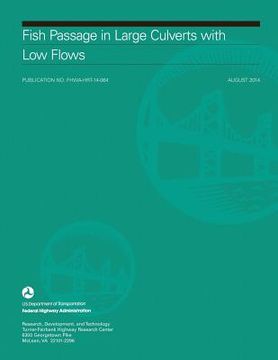Reseña del libro "Fish Passage in Large Culverts with Low Flows (en Inglés)"
Historically, culverts have been designed for hydraulic efficiency without consideration of fish passage or, more generally, aquatic organism passage. Over time, it has become apparent that culverts frequently become impediments to healthy aquatic ecosystems because they can prevent the movement of fish and other aquatic organisms upstream and downstream through the culvert. Therefore, aquatic organism passage through culverts has become an important design element component for road/stream crossings. Common physical characteristics that may create barriers include high water velocity, shallow water depth, large outlet drop heights, turbulence within the culvert, and accumulation of debris. Sediment deposition and erosion at the culvert may also create a barrier to passage. Culvert length, slope, and roughness may create conditions that impede passage as well. Further complicating design is that passage needs differ by species, life stage, and season. To address this complex task, the Federal Highway Administration (FHWA) developed a stream simulation approach for designing culverts. Stream simulation is based on the concept that if conditions inside a culvert are similar to those conditions in the stream upstream and downstream of the culvert, then aquatic organism passage will be provided without consideration of the specific physical requirements of one or more species. However, stream simulation is not appropriate for all situations. For example, an existing culvert that is blocking passage may not be a good candidate for replacement using stream simulation because of the size of the embankment or insufficient budget for a replacement. Applications of stream simulation may also be limited for new culvert installations. Site constraints or budget limits could dictate a smaller culvert installation than would be recommended by stream simulation. In these cases, it may be desirable to design a culvert crossing considering the specific passage needs of a specific species of fish. Doing so requires an understanding of the migration seasonality, life stage swimming capabilities, and stream flow rates expected during passage. Ideally, this information is developed by a multidisciplinary team of aquatic biologists, hydrologists, and engineers. From this information, the maximum velocity and minimum depth requirements for the target fish are derived. Considering only average velocity in a culvert masks that there are zones within the flow field where velocities both higher and lower than the average exist. The objective of this research is to assist in the design of culverts for fish passage by 1) identifying zones of lower velocity that are conducive to fish passage and 2) developing practical design methods quantifying these lower velocity zones.

